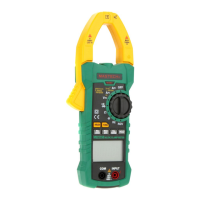01 02
1. Safety Information
Please particularly note that inappropriate use may
cause shock or damage to the meter when using.
When using the meter, comply with common safety
procedures and completely follow the safety measures
stated in the operation manual.
In order to make full use of the meter's functions and
ensure safe operation, please carefully read and
follow the procedures in the operation manual.
This meter meets to UL/CAS61010-1 with measurement
category (CAT lV 600V and CAT III 1000V.) and pollution
degreease follow the safety guidelines to ensure safe
usage of the meter.
Protection provided by the instrument will be impaired
if used in a manner not specified by the manufacturer.
The meter will provide satisfactory services to you if
you use and protect it appropriately.
1.1 Preparation
1.1.1 When using the meter, the user should comply
with standard safety rules for:
- General shock protection
- Proper use of the meter
1.1.2 Please check for damage caused during
transportation after receiving the meter.
1.1.3 If the meter is stored and shipped under hard
conditions, please confirm that the meter
operates properly or is damaged.
1.2 Usage
1.2.1 When using the meter, select the right function
and measuring range.
1.2.2 Don't make measurements that exceed indicated
values in each measuring range.
1.2.3 When measuring circuits with the meter
connected, do not contact with probe tip
(metal part).
1.2.4 If voltage to be measured is more than 60V DC or
30V AC (RMS), always keep your fingers behind
finger protection device.
1.2.5 Do not measure voltage greater than AC 750V.
1.2.6 When selecting the manual measuring range, if
you don't know the value to be measured, choose
the highest measuring range and decrease
gradually until the correct range is displayed.
1.2.7 Before rotating selection switch to change
measuring function, remove probe from the
circuit to be measured.
1.2.8 Don't measure resistors, capacitors, diodes and
circuit connections with power.
1.2.9 During tests of current, resistors, capacitors,
diodes and circuit connections, avoid connecting
the meter to voltage source.
1.2.10 Do not measure capacitance before capacitor is
discharged completely.
1.1.4 Probe should be in good condition. Before use,
please check whether the probe insulation is
damaged and whether the metal wire is bare.
1.1.5 Use the probe table provided with the meter to
ensure safety. If necessary, replaced the probe
with another identical probe or one with the same
specification.
Warning

